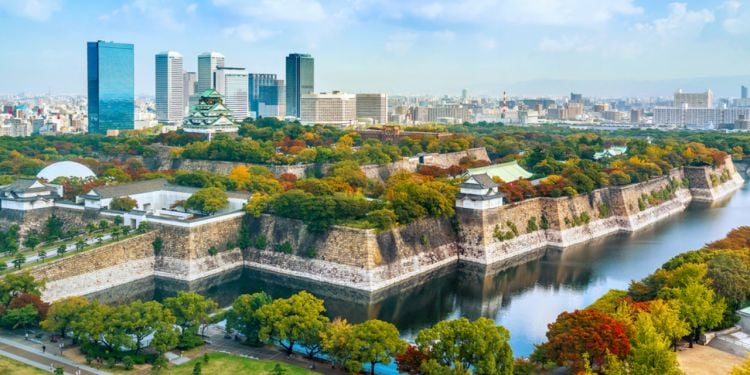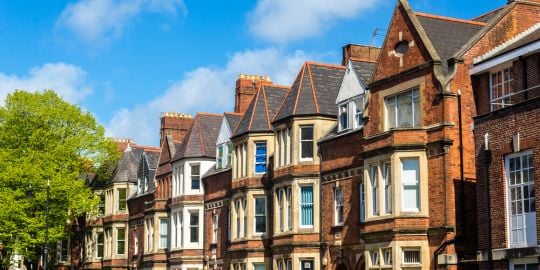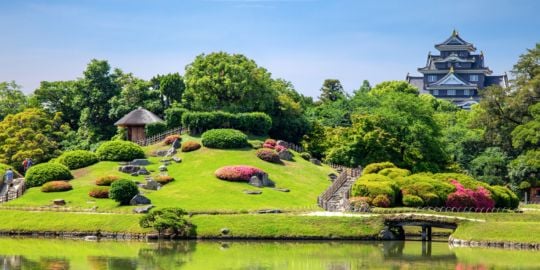Accommodation in Osaka

Osaka is the 3rd most populated city in Japan and is only 2.5 hours from the capital Tokyo by shinkansen high-speed train. People often say that time passes differently in Osaka. Maybe because of the city's laid-back atmosphere or because of its contrasting neighborhoods. But where to stay in Osaka? What types of accommodation are available there?
The districts of Osaka Prefecture
Osaka Prefecture is not the same as Osaka City, which is the capital of the eponymous prefecture. This article focuses on the city.
The prefecture has 24 districts (ku): Abeno-ku, Asahi-ku, Chûô-ku, Fukushima-ku, Higashinari-ku, Higashisumiyoshi-ku, Higashiyodogawa-ku, Hirano-ku, Ikuno-ku, Joto-ku, Kita-ku, Konohana-ku, Minato-ku, Miyakojima-ku, Naniwa-ku, Nishi-ku, Nishinari-ku, Nishiyodogawa-ku, Suminoe-ku, Sumiyoshi-ku, Taisho-ku, Tennôji-ku, Tsurumi-ku, Yodogawa-ku.
Kita-ku, Minato-ku, Tennôji-ku, Nishi-ku and Joto-ku are the most popular districts. For a more peaceful environment, Yodogawa-ku and Sumiyoshi-ku are the places to be.
The districts of Osaka
It is easy to cross Osaka from one side to the other. Far from the sprawling Tokyo, Osaka is a human-sized city. A two hours walk will make you discover all the wonders of the city.
Start from Shin Osaka, a station served by the Shinkansen high-speed train. You can continue on foot or take the Midosuji subway. The subway crosses most of the districts of Osaka: northbound (kita), with Umeda district, central, with Yodoyabashi and Honmachi, southbound (minami), with Shinsaibashi and Namba. If you go towards the east, you will come across the Osaka castle district. In the extreme south, you will find the Tennôji district. To the southwest, you are in Osaka Bay, so be ready to enjoy the cool sea breeze and to take a well-deserved break in one of the restaurants of the district.
Life in Osaka revolves around these poles: the two big blocks Kita and Minami (North and South), the East block of Osaka Castle, and the seaside area, Osaka Bay to the South-West.
Shin-Osaka
Shin-Osaka itself is not a district. It owes its name to the station through which the Shinkansen passes. But Shin-Osaka is more than just a station. As often in Japan, convenience has been combined with practicality. Shin-Osaka has two areas dedicated to food and shopping: Eki market Shin-Osaka (Shin-Osaka station market) and Arde! Shin-Osaka. If you are looking for a place to stay in Osaka, you will find different types of accommodation depending on your location and budget: family hotels, luxury hotels, mid-range hotels, and discount hotels.
Kita Osaka
To the north, you will find Umeda (in Kita-ku), the business district of Osaka. It is easily identified by its Umeda sky building, an ultramodern skyscraper built during the speculation boom. In the center of Umeda is the huge Osaka station and its multiple shops. The skyscraper and its 360° observatory are popular with tourists. Umeda also has its temple, the Tenmangu, and museums (National Art Museum, Oriental Ceramics Museum, Osaka Life and Housing Museum, Kids Plaza Palace). Nakanoshima Park is the green parenthesis of Umeda, ideal for escaping the urban rush. Hep Five and Tenjimbashi-suji are the two shopping and entertainment arteries of the district.
Minami Osaka
Most of the attractions and entertainment areas are located in the south of Osaka. Evenings are festive, and the streets are particularly lively. The two major districts in the south are Namba and Shinsaibashi. Many foreigners choose to rent accommodation in southern Osaka. Whether it is for a short or a long stay, the accommodation offers are more varied and numerous. There are apartments, houses, hotels, ryokan (traditional inn), sharehouses, and so on. They are many more in the south of Osaka.
Namba
Located at the border between Chûô-ku and Naniwa-ku, Namba is the most animated district of Osaka. It is recognizable by its emblem, the famous Glico, perched on the Dotonbôri canal (it is also where the tourist neighbor Shinsaibashi suji is located). Dotonbôri is symbolic and concentrates all the festive spirit of Osaka. With its shopping malls, restaurants, and boutiques, Namba is crowded from dawn to dusk. On the north side of the canal, the America mura will take you in an American hip-hop atmosphere. To the east, the Dogoyasuji shopping area and Den den town, the high-tech den, nicknamed "the little Akihabara" in reference to the Tokyo electronic district.
Shinsaibashi
Right next to Namba, Shinsaibashi is the other lively district of Osaka. Its emblematic street, Shinsaibashi suji, stretches over 600 meters. It is even 2km if we include all the shopping zones. Like Namba, Shinsaibashi has many assets: many fashion stores, restaurants, and entertainment areas. Cosmetic stores are the particularity of Shinsaibashi. Tourists flock there to buy cosmetics at competitive prices.
Osaka center (Honmachi)
Between the north and the south lies Honmachi. The place is much quieter than the ultramodern Umeda or the festive districts of Namba and Shinsaibashi. Unlike other districts, Honmachi is neither known for its attractions nor for the wonders of its architecture. The area is quiet and ideally located for easy access to the north and south of the city. There are both mid-range and luxury hotels. You will also find a large park, Utsubo kôen, known as one of the best spots to enjoy cherry blossoms (hanami).
Osaka Castle
Every year (except during Covid), Osaka Castle, its museum and its park are crowded with visitors. Tourists come in large numbers to admire the castle. Locals also come to enjoy a relaxing day. The castle and its garden are well integrated into their space. Joggers go around the castle while families rest or picnic in the park. It is part of history and everyday life. The castle is accessible to all, whether you have a disability or not. Unlike other countries, Japan does not hesitate to rebuild its historical monuments. For the Japanese, it doesn't matter if the stone is authentic or not. What matters is that the memory survives the years. The monument, on the other hand, is bound to evolve with time.
Tennôji and Abeno districts
Abeno and Tennôji make up the retro district of Osaka, where the famous "Shinsekai", the new world, is located. The real heart of the district, the Shinsekai is a joyful vintage place with a colorful and offbeat decor. It is home to vintage clothing stores, restaurants, hairdressers, etc. The atmosphere is unique. The Shinsekai is like a passage from one world to another, like a relaxing break in the middle of daily activities. Needless to say, it has become a popular place for visitors in all seasons. In the distance, you can visit Abeno Tower, also a relic of a festive futuristic past.
Osaka Bay
Lost in the city center, we could forget that Osaka is a port city. The bay revives our memory and offers a wide choice of entertainment and good deals. This is where Universal Japan Studios and Tempozan, a huge complex including the Osaka Aquarium, a Ferris wheel, and a shopping and dining area, are located.
Types of accommodation in Osaka
There are enough properties and accommodations in Osaka to suit your needs and budget.
Housing options for short stays
For a short stay (vacation, business trip, internship of less than 90 days), you can opt for a hotel, sharehouse, Airbnb or ryokan (traditional inn) rental. But be careful with Airbnb. Establishments offering rooms for rent must comply with new regulations, which have been in force since 2018.
The cheapest solution remains the dormitory. Count about 30,000 yen per month. For more privacy, look for hotels, apartments and ryokan. Rental prices in Osaka will vary according to several factors like the season, the location (proximity to train stations, etc.), and the services offered. Still, you can find low-cost accommodation for less than 1500 yen per night.
Important:
All travelers to Japan now need a visa, even for short stays.
Housing options for long stays
If you work, study, or are the holder of a Working Holiday Visa in Japan, you might be more interested in an apartment or a house, especially if you are going with friends or family. In Osaka, like in the capital (or elsewhere in Japan), apartments and houses are often rented unfurnished. Sharehouses, on the other hand, are furnished. For a few years now, a new type of sharehouse called social residence has been emerging in big Japanese cities. You can thus rent a spacious room and enjoy more common spaces, such as a cinema room, gym, mini-cafe, game room, and coworking spaces, than in a classic sharehouse. The services differ depending on the type of establishment. This type of shared accommodation works on the principle of community and are a kind of melting pot. Japanese and foreigners mix, share and communicate. However, the prices are higher than for a classic sharehouse.
Good to know:
This type of shared accommodation is not available for short-term rentals. In general, you have to rent for at least 6 months. If you are interested, ask about the entry requirements.
Rent prices in Osaka
In Osaka, like in Tokyo and other cities, rental prices depend on the type and size of the property, its location, its year of construction, and the duration of stay, among other factors. A property near public transportation (Osaka station, for example) may be more expensive. But it is a strategic choice, especially if you plan to move a lot. Osaka Station connects you to Tokyo via the Shinkansen. Staying in Osaka also brings you closer to Kyoto and Nara, which means you can go there by train and subway. If you push a little further, you will reach Kobe. So, staying in Osaka is really a good choice, whether you are on a short-term or long-term stay in Osaka.
Price ranges
Compared to Tokyo, you can find bigger and cheaper apartments in Osaka. Count around 24,000 yen for a 14m² apartment 5 minutes away from Shimoshinjou station. Older apartments are the most affordable; most of them date back to 1988 and cost around 24,000 yen. Newer units are logically more expensive. As for expensive rentals, there are 330m² apartments near Daikokuchô station for around 1,500,000 yen per month. It is still cheaper than in Tokyo. If you are alone, you can find a bedroom/living room/bathroom/kitchen apartment for about 400,000 yen per month, for a total area of 146m².
Finding accommodation in Osaka through a real estate agency
You can choose between two types of agencies: fudôsanya, classic real estate agencies, and agencies specialized in renting to foreigners. Fudôsanya usually charge extra fees. If you speak Japanese, do not hesitate to use a traditional agency. They sometimes offer more properties for cheaper. However, some of them are still reluctant to deal with foreigners.
Good to know:
Agency fees have not totally disappeared, and can also be found in international agencies. The agency may ask you for a deposit, fire insurance, agency fees, guarantor fees, etc. Make sure you check all the information before signing the lease, because these fees can increase the price. Don't forget that the lease is usually for two years.
More tips for finding accommodation in Osaka
Osaka's property market is huge, and there are many websites and real estate agencies to choose from. Websites in English will facilitate your search.
Depending on the agency, it is not always possible to visit a sharehouse. Some agencies will ask you to make a booking and therefore pay before you move in.
Whether you are here for a short or long stay, invest in a transportation card. Valid throughout Japan, the Suica card costs only 2,000 yen. For the same price, choose the "personal card" option to enter your details and be protected in case of loss.
If you don't know speak Japanese, consider taking language courses before moving.
Useful links:









